I’ve been getting some actual garden time lately. It’s still a complete bomb site, but it’s better than it was a month ago. I got a little lax on it over summer. More recently that’s meant we’ve been eating less out of the garden. The food isn’t really there. It’s not there because I didn’t plant it.
As much as I’m trying to establish a garden that grows itself, I’m still working on that. Things had fallen a bit behind. So I’ve been using the mantra “if you don’t plant it, you can’t eat it” and trying to get back out there more often.
And honestly, yesterday I had no blog ideas. So today I’m taking you on a tour of the garden. At the moment, the beds are (roughly) ordered by when they were created as the entire garden is still in progress… but it’s getting there.
Bed 1
I’d basically abandoned this bed. It slopes on some weird angles and was difficult to keep free of kikuyu. But it kept growing things. The odd self-sown pak choi, a nasturtium, and a tobacco plant which has now been growing there for 2 years.

Then, a couple of weeks ago I felt inspired enough to weed out half the bed and throw in some things that had been sitting in pots for far too long. In went some chives, parcel, swan plants, catnip, and California poppies. It will be a beneficial insect bed.
This bed sits outside the current fence and the dogs have since dug a bit up. Half of it is still choked with clover and kikuyu, but I’ll get there. This week I stumbled across a couple of packets of beneficial insect blend, so I’ll try have it ready to chuck that through in September.
Bed 2
Bed 2 is a “split bed” – I usually run two sets of crops in it. The top end is currently holding the winter crops (peas, pak choi, rocket). While the lower end has just had the chooks put through to tidy it up after the summer crops.

The vacant end of this bed will hold my final attempt at growing Printanor garlic. They’re due to be planted in August in line with the commercial guys to see what happens. Now the chooks have been through, it’s time to add organic matter, lime, and blood and bone again.
Bed 3
The new garlic bed.
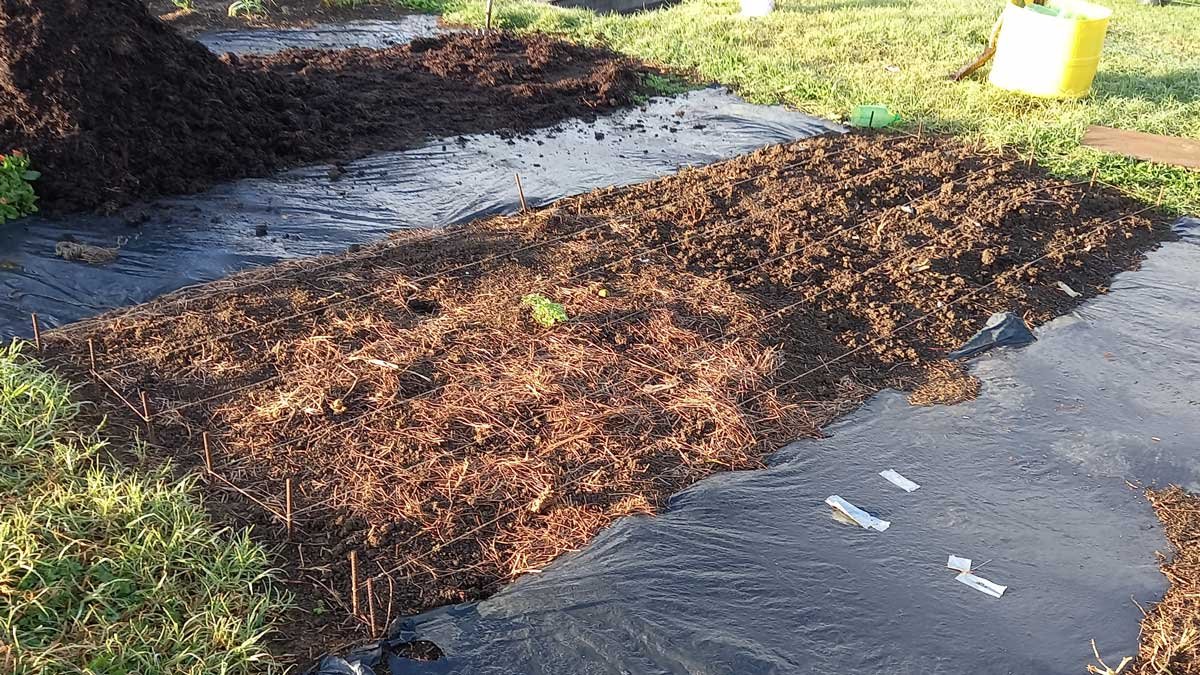
Needs some TLC, but waiting for those garlics to pop up first. Shouldn’t be too far away now.
Bed 4
The compost bed. This bed has spent most of 2021 making compost as I’ve flicked the pile back and forth. We’ve started using some of it, but there’s some spots that still need a little longer.

So we turned it again a couple of days ago. I’m hoping to have it off by the end of the July so Richard can use it for his projects over summer.
Bed 5
This is the ‘non-BAS-50’ strawberry bed. I’ve tidied up the strawberries, but I haven’t decided whether I’ll keep it as strawberries, or maybe turn it into a ‘summer salad’ bed. One of my big problems in summer is irrigation. I don’t want to spend our precious water on the garden, so I don’t, and the garden suffers. Then my motivation for gardening suffers.
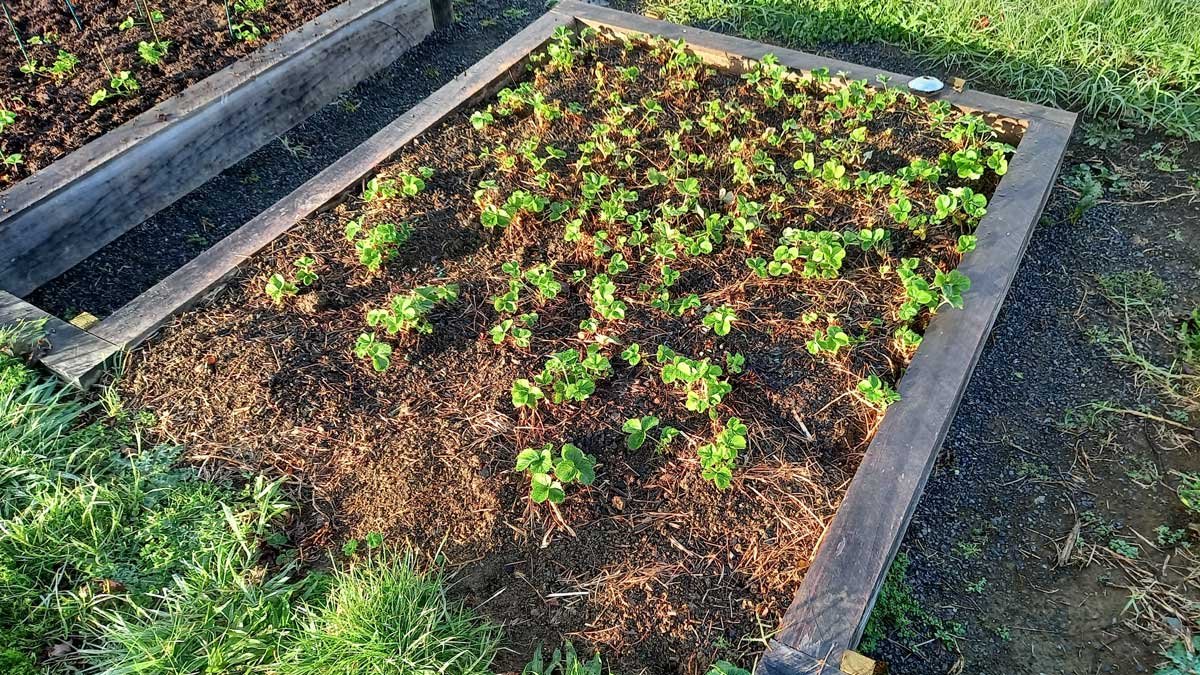
But this bed is small enough that I could cover it with mikroclima – a cover that helps keep the microclimate stable through the seasons. It’s close enough to the tank that I could spend some precious water on keeping at least one bed nice and happy. Maybe I’ll be less likely to lose my gardening mojo over summer if one bed is actually pumping.
If I do that, it means ripping out the strawberries. I’ll still be left with the better bed of berries, but I’m just taking some time to consider things first.
Bed 6
The BAS-50 strawberry bed. This week I’ve pulled out the extra runners, and refreshed a couple of plants. Then I added some soil amendments and a layer of the home-made compost.
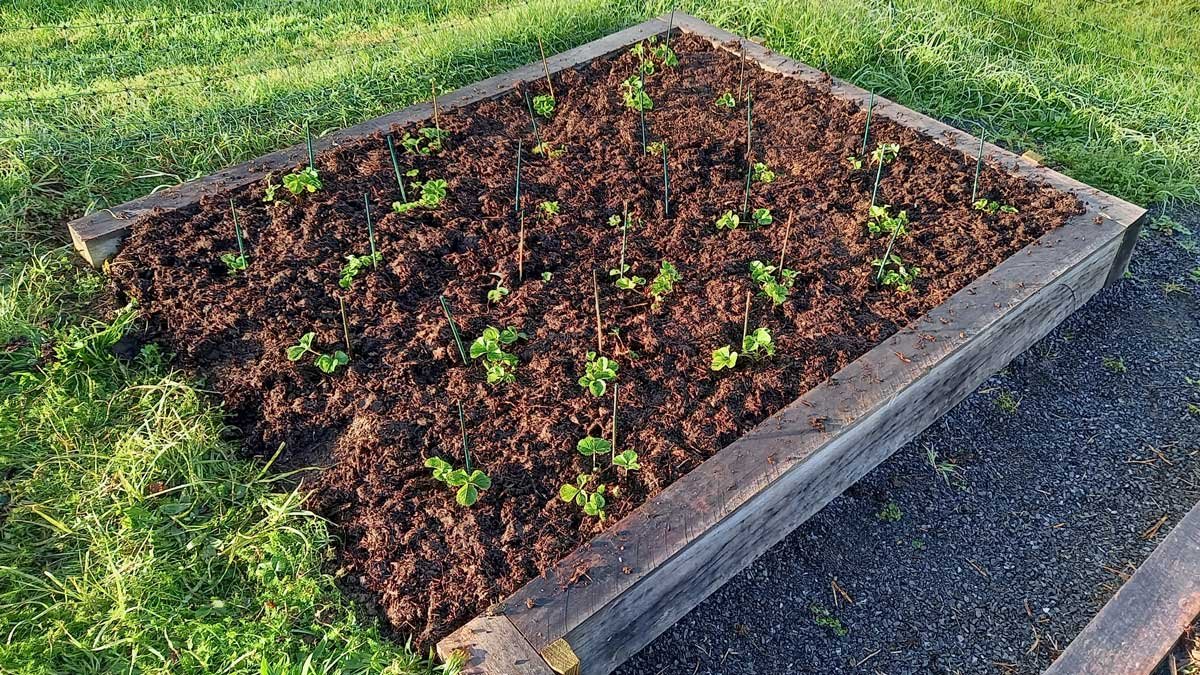
I was really impressed with the quality of the compost – it’s positively wriggling with worms. And the majority of the plants in this bed are heading into their second year. Fingers crossed it pumps this summer.
Bed 7
I split last year’s garlic bed into 2 beds. Bed 7 is home to catnip, some self-sown garlic, and some broccoli that went in too late.

Last year I got my broccoli perfect. I planted it at the right time, and I looked after it perfectly. This year is quite a different story. So my broccoli plants are a bit behind and chewed out by caterpillars and slugs. But hopefully spring will bring us some good broccoli.
Bed 8
The other half of the old garlic bed. This is going to be a bit of a random one for a few months at least. I have some silverbeet seedlings and more pak choi to put in here. It’s currently home to self-sown garlic, self-sown parsley, and some planks of wood.
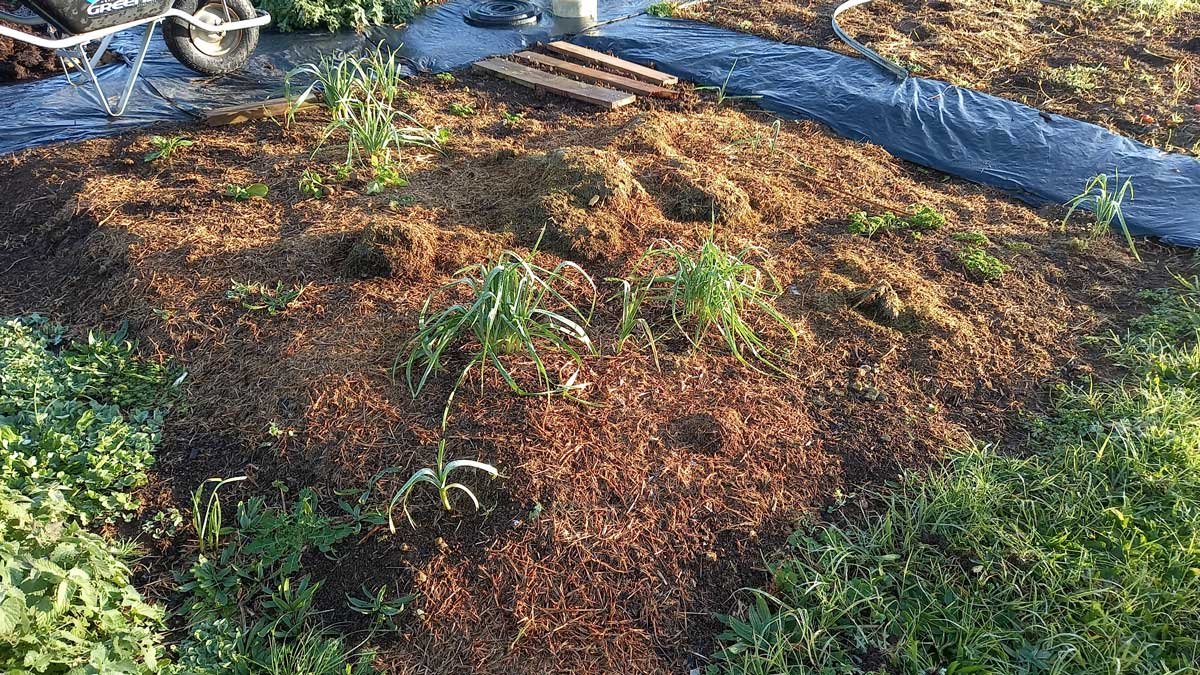
The planks of wood are a new technique I’m trying to germinate carrot seed. Our carrot germination has always been a little… spotty. Probably because I’m so lax about watering.
I’ve gone down a little research hole. Turns out carrots need an even moisture to germinate, but they don’t need light. A blog I read at Kings Seeds recommended covering the seed with some planks of wood and lifting them when you see germination. So I sowed some carrot seed, let a rain shower water them in, then covered them with some planks of wood. There’s at least a week before I find out if it worked.
Bed 9
I hate this bed so much right now.
We got it ready for its first planting over summer. It grew mini pumpkins, and did a great job.
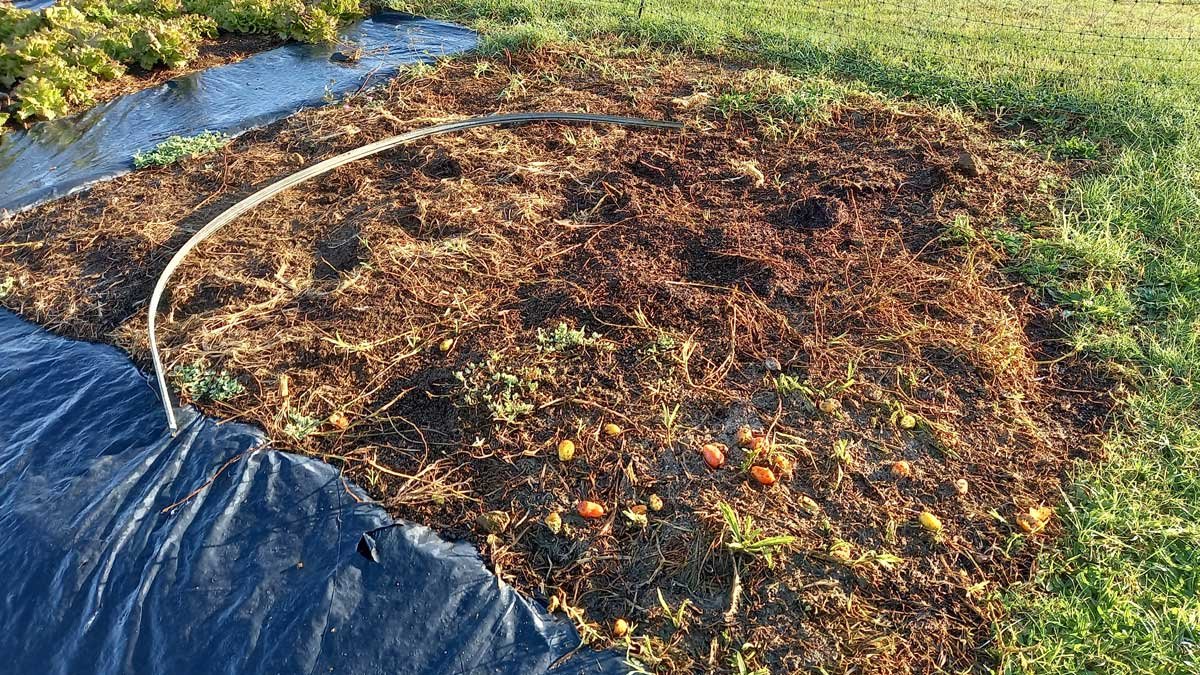
However, pumpkins are always a great crop for letting kikuyu take over in my gardening experience. This summer was no exception. We ran the chickens over it, and this is what it looks like now. There is kikuyu right through it. It’s a nightmare.
I have two options: cover it up with PVC for a few months and starve the kikuyu of light. Or blast it with glyphosate. My plan is to use it for Agria potatoes in late September, so I do have the time to kill it off with plastic (and likely will), but I hate it so much I’m frankly half-tempted to nuke it.
Bed 10
Home to more catnip, leeks, self-sown lettuce, and disappointing carrots. This is the bed that includes gorse in its weed load. That’s always fun to find amongst the carrots.

The leeks I planted are doing great. We’ve been eating them out of the garden for about a month now. Richard dared me to grow the fattest leek with the longest white shank I could, so I got a bit creative about it.
I took a few old 2.25l Sprite bottles and cut off the top and bottom of each, then threaded a bottle over each leek and twisted it into the ground. Next, I filled around each leek with dirt, meaning that each leek has a raised ‘sleeve’ above ground level. The sleeve will blanch the shank, leaving us with white shanks (at least, in theory).
These leeks will need a thorough washing before use, but hopefully I’ll make the goal of fat leeks with long white shanks.
The lettuces are doing ok, but they’ll bolt to seed soon. Obviously, I plan to let a couple of them do that, but then I’ll rip the rest up and put some green manure in the top half over spring and summer. I’m thinking blue lupin and phacelia. I’ll cut down most of it before it flowers, but leave some at the end as a barrier for the grass and insect-attractors.
Bed 11
A new bed! This one has been covered with plastic for the better part of a year, but I need the space for Jersey Bennes potatoes at the end of July, so this week we lifted the plastic, marked it out, and ran the rotary hoe through it.

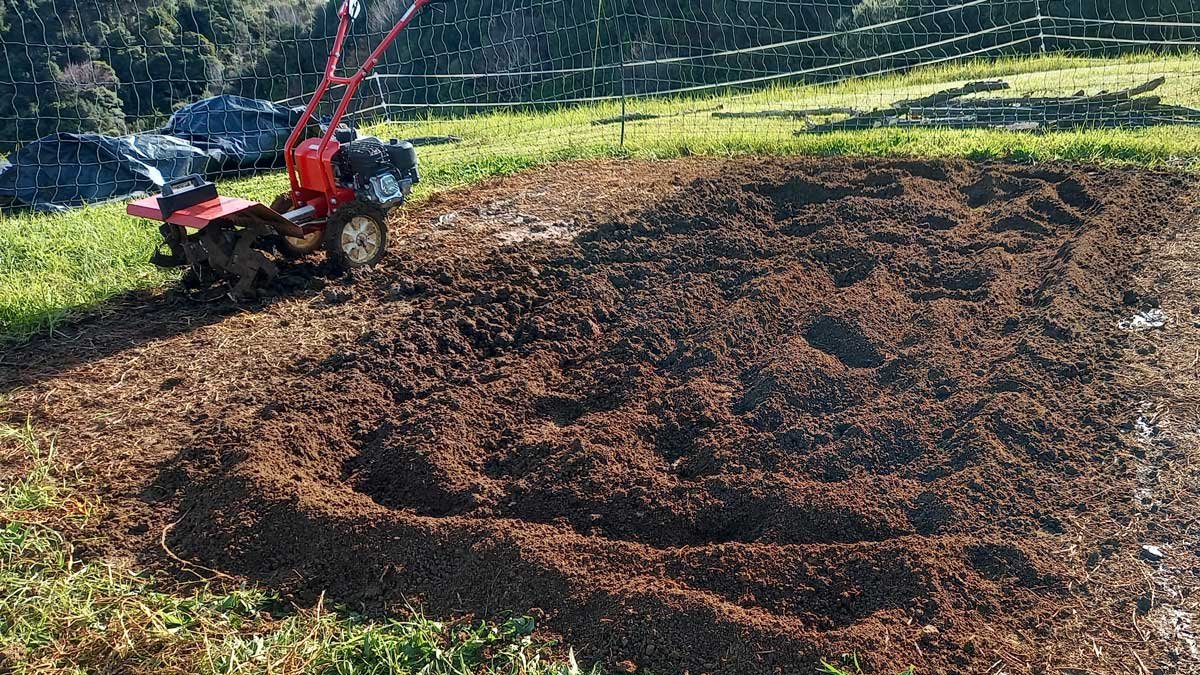
Per our usual plan, this bed will get a load of manure, blood and bone, BAS-50, and NanoCal. It will not get lime. I’ve been doing potatoes all wrong by adding lime, so I’m told. Even though at this point I’ve shifted to gypsum, which won’t affect the pH, I’m taking the advice to not lime my potatoes this year.
Beds 12-14
Still grass.

Now Bed 11 is coming to life, it’s time to cover these beds to kill off the grass. I’m still making up my mind on whether to extend the terracing like the strawberry beds down the line, but I think they’ll need something. It’s very uneven and I just haven’t quite decided how to work with that.
And beyond…
There’s still so much to do. A more permanent fence, less grass, something to harvest and distribute water, paths to level out… not to mention the three beds that we haven’t even started yet.
It’s taken two years to get to this point. There are eleven beds that have been created, and which do feed us – sometimes even without much effort. But gardening is not free food. It’s the exchange of energy, and I’m enjoying spending more energy in my garden recently.


